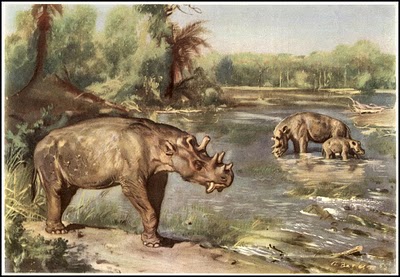 Dinocerata: Bathyopsis, Dinoceras, Ditetradon, Eobasileus, Gobiatherium, Jiaoluotherium, Probathyopsis, Prodinoceras, Tetheopsis, Uintatherium; uintatheres.
Dinocerata: Bathyopsis, Dinoceras, Ditetradon, Eobasileus, Gobiatherium, Jiaoluotherium, Probathyopsis, Prodinoceras, Tetheopsis, Uintatherium; uintatheres.| Archaic Mammals | ||
| The Vertebrates | Dinocerata |
| Vertebrates Home | Vertebrate | Vertebrate |
|
Abbreviated Dendrogram
Eutheria
├?──┬─Palaeoryctidae
│ └?─┬─Pantolesta
│ └─Ptolemaiidae
├?──┬─Pantodonta
│ └─Tillodontia
├?─Taeniodonta
├?─Dinocerata
╞?═Creodonts
├─Boreoeutheria
├─Afrotheria
└─Xenarthra
|
Contents
Overview |
Taxa on This Page

Uintatherium, artwork by Zdenek Burian
Among the most impressive looking of all Tertiary animals, the Dinocerata ("terrible horns") were a disitinctive group of rhinoceros-like hoofed herbivores of uncertain phylogenetic relationships. Neither long lived nor particularilyu diverse or widespread, their claim to fame rests on the fact that not only were they the first giant animals to appear since the extinction of the dinosaurs, but they were also equipped with an array of awesome acutriments, fearsome-looking tusks and - in advanced forms, three pairs of knobby horns, and the smallest brain to body-weight ration of any mammal living or extinct.
Interestingly the Dinocerata, or Uintatheres as they are also called (the group contains a single family - Uintatheriidae - with less than a dozen, mostly monospecific, genera) were the first of a number of rhinoceras morphotypes. They were succeeded in the late Eocene by the even larger Brontotheres (Titanotheres) which in turn were replaced by true rhonos and, in Africa for a short period during the early Oligocene, the bizarre, twin-horned Arsinotheres. In each case we are looking at animals of several tonnes in weight, who when fully grown been large and powerful enough to easily resist any contemporary predator. Indeed, for many of these animals the horns were actually small and blunt; only the arsinotheres and several rhino lineages had horns that could have been used as weapons. As with sauropods and elephants, size alone offers a great selective advantage
But despite their commanding presence, the uintatheres did not survive the end mid Eocene (at one time believed to be the end Eocene, until the stratigraphy was corrected) turnover. ,Perhaps they were too specialised as regards diet or behavior. Their sudden disappearance paved the way for the next radiation of giant herbivores, the brontotheres, who, despite their rhino-like appearance, were actually the overgrown cousins of early horses. MAK120716
 Dinocerata: Bathyopsis, Dinoceras, Ditetradon, Eobasileus, Gobiatherium, Jiaoluotherium, Probathyopsis, Prodinoceras, Tetheopsis, Uintatherium; uintatheres.
Dinocerata: Bathyopsis, Dinoceras, Ditetradon, Eobasileus, Gobiatherium, Jiaoluotherium, Probathyopsis, Prodinoceras, Tetheopsis, Uintatherium; uintatheres.
Range: Late Paleocene to Middle Eocene of North America & Asia.
Phylogeny: Ungulatomorpha :: Ungulata + *.
Characters: up to rhino size & 4500 kg (but most forms pig-size); upper incisors usually absent; enlarged canines with flange in lower jaw (size of tusks sexually dimorphic); molars somewhat similar to perissodactyls; V-shape crest on P3-M3 with apex at protocone (see image at right); lower molars with tall trigonid and prominent metalophid (= metacristid); hypolophid (= ?) absent; superficial resemblance to rhinoceros with 0-6 blunt paired facial horns, probably skin-covered (like giraffid artiodactyls); short legs.
Links: Dinocerata Catalogue; Dinocerata; Teeth, Tusks and Tarpits 1 (Knight painting); paleng3 99p308abs; Paleocene mammals of the world; A Pallas nagy lexikona (Hungarian); EOCENO Mamíferos (Spanish); Chronologia Proshessov (Russian); earlyimage; phseb2.html; James Baird Gallery : Search Results: 17 of 24; Uintatherium Skull Replica from Antiquarian Fossils; uintatherium French); Ice Age Mammals - EnchantedLearning.com. links checked ATW040213
Images: Right : Eobasileus right P3-M3 from the Burke Museum. Left: unidentified uintatheres and early perissodactyls from the former Field Museum site. Painting by Charles Allen Knight, which I've done my best to digitally restore to something more closely resembling its original color scheme. ATW011124.
checked ATW040213. This page MAK120716